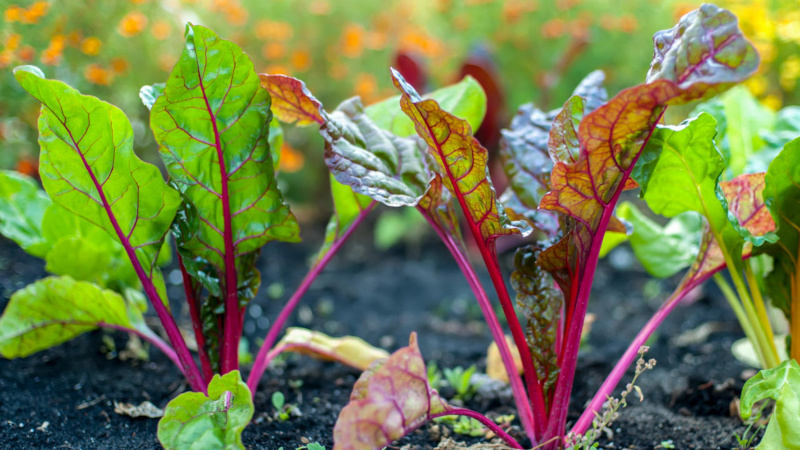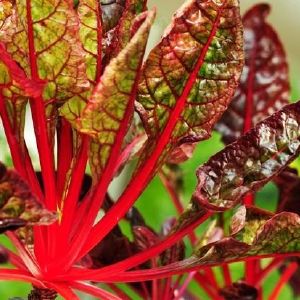Why do beet leaves turn red and what to do about it?
Beetroot have been eating for more than one millennium. Initially, the dishes were prepared only from beet tops, and the roots were not eaten. At first, a healthy vegetable was cultivated only in the Mediterranean islands. Late beets spread to all continents
The culture is unpretentious and does not require special care. However, difficulties arise in the process of growing it. An indicator of the health and proper development of a vegetable is the state of the tops. Errors in care lead to the fact that the leaves dry out, change color, become stained. In the article, we will figure out why the leaves of beets turn red and how to feed the vegetable if it lags behind in growth.
The content of the article
Causes of reddening of beet leaves

Redness of the tops does not always signal that the vegetable is unhealthy. there is beet varieties, a distinctive feature of which is the reddish tint of the leaves (Sugar and Burgundy varieties). In this case, the unusual color of the tops is the norm. Such features of the variety are indicated by the seed producer on the package, so before planting, you should carefully study all the information on the package.
If the selected variety does not have such a characteristic feature, then the reddening of the tops indicates a violation of the rules of care or a disease of root crops. There are several reasons for this phenomenon.
Insufficient sodium content in soil
Normal sodium content in soil is important in the initial phases of plant growth and development. Young beetroot sprouts absorb sodium, calcium and magnesium from the soil especially intensively. Lack of sodium negatively affects the development of plants, preventing them from assimilating phosphorus and nitrogen in sufficient quantities.
Sodium enhances the growth of tops, increases enzymatic activity, promotes the accumulation of sugar in root crops.
Insufficient content of potassium and phosphorus in the soil
Another reason for the appearance of burgundy leaves lies in the lack of potassium and phosphorus. If the beet leaves turn dark red at the edges, this indicates an insufficient potassium content in the soil. This phenomenon is also called edge-shaped beet necrosis. In cases of acute lack of potassium in plants, leaves curl and dry out.
With a phosphorus deficiency, the tops first acquire a dark green color, and after a while they turn red.
Increased acidity of the soil
Beetroot is sensitive to soil acidity. Acidity is the most common cause of red and purple leaves in beet beds.
Attention. In acidic soil, beets grow unsightly small leaves, and root crops develop poorly.
Checking the acidity of the soil is easy at home. For this purpose, special acidity analyzers are suitable, which are sold in horticultural centers (litmus paper, Alyamovsky's device, soil composition analyzers).
From folk methods, they use a test with vinegar and hydrochloric acid. Such methods are not so reliable, but they are quick to use and affordable. A clod of earth from the garden is watered with strong hydrochloric acid or table vinegar. If wetted soil reacts with the formation of bubbles, then the soil is alkaline. If there is no reaction, neutral or sour.
Ways to solve the problem
What should be done if the tops turn red and the root crop itself does not grow well? How to determine what is missing in a vegetable and how to water the beds to solve the problem? Depending on the cause of foliage reddening, the following measures are applied.
The sodium content of the soil is increased in a simple way. Beet plantings are watered with water and salt (200 g of table salt per 10 liters of water). For 1 m² of the garden use 1-2 liters of solution. In this case, watering is carried out not at the root, but directly along the tops.
Attention. The excess sodium content in the soil, which is characteristic of alkaline soils, has a detrimental effect on the yield of beets.
The introduction of appropriate fertilizers will help to fill the lack of potassium and phosphorus in the soil. Regular feeding increases the yield of root crops by 1.5 times. When applying fertilizers, it is important to observe the dosage recommended by the manufacturer. An excess of nutrients leads to the accumulation of nitrates in the fruit.
Need to know. The application of potassium-phosphorus fertilizers to acidic soil does not give the desired effect. In an acidic environment, phosphorus turns into compounds that are difficult to assimilate and is not assimilated by plants.
Wood ash helps to reduce the acidity of the soil. Beetroot beds are abundantly sprinkled with it. It is good to combine top dressing with watering. To prepare a solution, 2-3 glasses of wood ash are mixed with 10 liters of water. The solution is thoroughly mixed before watering.
To reduce acidity in the fall, while digging the garden, dolomite flour and chalk (500 g per 1 m²) are added to the soil.
Proper care of beets
A rich crop of root crops cannot be grown without proper plant care. The beds with beets need to remove weeds and loosen, thin out, water, and apply fertilizers.
Weed removal and soil loosening
The threat posed by weeds is great in the early stages of crop growth. Until a rosette of 4-6 leaves is formed, beets grow slowly. If left untreated, weeds will prevent young plants from growing.
Weed removal is combined with loosening the topsoil. This procedure increases gas exchange in the upper soil layer and helps to retain moisture.
Thinning
Beet seeds are multi-fruited, that is, from 2 to 4 plants appear from one seed, so thinning cannot be avoided.
Densely growing fruits take resources away from each other, which has a bad effect on the yield, size and quality of root crops. The root system of beets grown without thinning is small and underdeveloped.
Council. Transplant healthy plants discarded during thinning to free space. Beets tolerate transplanting well.
The first thinning is carried out when the first 2 full leaves are formed on young plants. At this stage, a distance of 2-3 cm is left between the seedlings in a row.
Thinning is repeated when a rosette of 5-6 leaves has formed on the plants. Now an interval of 4-6 cm is maintained between plants.
The last time the beets are thinned out in early August. This time, gaps of 8-10 cm are left between the plants.
Failure to comply with the terms of thinning negatively affects the quantity and quality of the crop. The optimal time for the procedure is after watering or heavy rain. Plants are easier to extract from wet soil, and transplanted specimens will more easily take root in a new place.
Watering
Beetroot grows well in evenly moist soil, but without excess moisture. In dry summers, the beet beds are watered regularly and abundantly. The vegetable is especially demanding for watering at the beginning of growth and at the stage of active growth of fruit mass.
Attention. Mulching the topsoil will preserve moisture and soil structure. This technique allows you to reduce the number of waterings and simplifies maintenance.
In August, watering is reduced, and 2-3 weeks before harvesting, they stop. This will help the roots accumulate more sugars and taste better.
Fertilization
Beets are fertilized when young plants have 3-4 leaves.Dry fertilizers are applied to the aisles simultaneously with loosening. About 8 g of potassium salt and 7-9 g of ammonium nitrate are used per 1 m².
The second time, fertilizer is applied shortly before the rows close. This time more fertilizers are applied: for 1 m² - 16-20 g of potash fertilizers and 10-15 g of nitrogen fertilizers.
Read also:
Favorite by farmers for its ease of care and taste, Cylindra beet variety.
Conclusion
Healthy bright green greens are the key to getting a good harvest of beets. If the foliage changes color, dries up, curls up, it means that the root crops lack nutrients. Another possible reason is the increased acidity of the soil. Competent and regular fertilization, as well as liming the soil (if necessary) will avoid problems such as reddening of beet leaves.